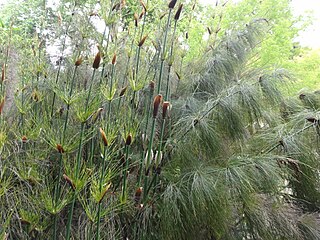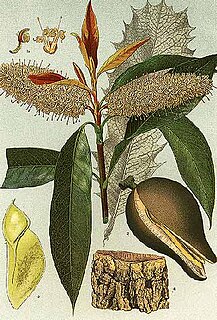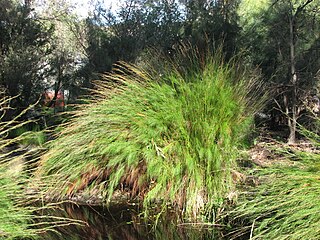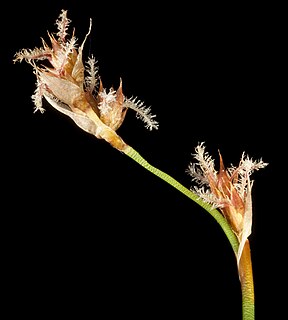
The Restionaceae, also called restiads and restios, are a family of flowering plants native to the Southern Hemisphere; they vary from a few centimeters to 3 meters in height. Following the APG IV (2016): the family now includes the former families Anarthriaceae, Centrolepidaceae and Lyginiaceae, and as such includes 51 genera with 572 known species. Based on evidence from fossil pollens, the Restionaceae likely originated more than 65 million years ago during the Late Cretaceous period, when the southern continents were still part of Gondwana.
Lawrence Alexander Sidney Johnson FAA, known as Lawrie Johnson, was an Australian taxonomic botanist. He worked at the Royal Botanic Gardens, Sydney, for the whole of his professional career, as a botanist (1948–1972), Director (1972–1985) and Honorary Research Associate (1986–1997).

Xylomelum is a genus of six species of flowering plants, often commonly known as woody pears, in the family Proteaceae and are endemic to Australia. Plants in this genus are tall shrubs or small trees with leaves arranged in opposite pairs, relatively small flowers arranged in spike-like groups, and the fruit a woody, more or less pear-shaped follicle.

The Grevilleoideae are a subfamily of the flowering plant family Proteaceae. Mainly restricted to the Southern Hemisphere, it contains around 46 genera and about 950 species. Genera include Banksia, Grevillea, and Macadamia.
Triunia is a genus of medium to tall shrubs or small trees found as understorey plants in rainforests of eastern Australia. Members of the plant family Proteaceae, they are notable for their poisonous fleshy fruits or drupes. Only one species, T. youngiana, is commonly seen in cultivation.

Acidonia microcarpa is a species of shrub in the plant family Proteaceae. It is the only species in the genus Acidonia. It is endemic to the south coast of the Southwest Botanic Province of Western Australia.

Apodasmia is a group of plants in the Restionaceae described as a genus in 1998. It is native to Australia, New Zealand, and Chile.

Baloskion is a genus of rush-like plants from Australia.
Malagasia is a monotypic genus of trees in the family Proteaceae. The sole species is Malagasia alticola, endemic to Madagascar.
Dapsilanthus is a genus of plants described as a genus in 1998.
Meeboldina is a plant genus in the family Restionaceae, described as a genus in 1943. It is named for the botanical collector Alfred Meebold.

Desmocladus is a genus of herbs in the family Restionaceae, all species of which are endemic to Australia, and found in Western Australia and South Australia. In this genus, the stems are the principal photosynthesizers.
Baloskion longipes, common name dense cordrush, is a dioecious perennial herb in the Restionaceae family, found in southeastern New South Wales.

Chaetanthus aristatus is a species of rush. It is found in Western Australia.

Chordifex microdon is a rush species of the genus Chordifex in the family Restionaceae, native to Western Australia.

Sporadanthus rivularis is a sedge-like herb in the Restionaceae family, native to Western Australia. It is a spreading perennial growing from rhizomes to heights of from 1 to 1.2 m, on black sands and clay along creek edges. It is a dioecious species.
Tyrbastes is a genus of flowering plants belonging to the family Restionaceae.
Tremulina is a genus of flowering plants belonging to the family Restionaceae.
Catacolea is a genus of flowering plants belonging to the family Restionaceae.
Cytogonidium is a genus of flowering plants belonging to the family Restionaceae.









